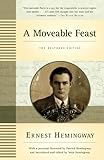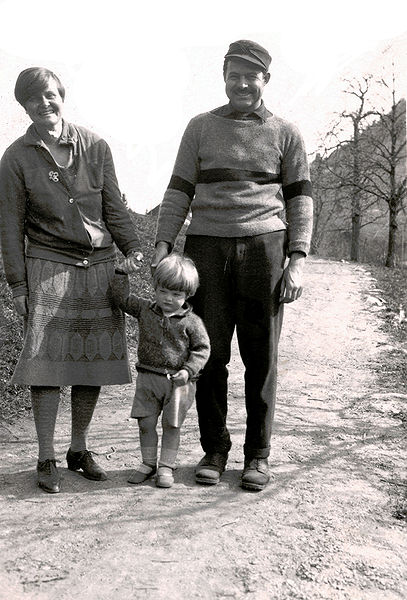 The trouble with posthumous publication is that you never know for sure if the book is the final result of the author’s intention because he or she wasn’t around during the final stages of editing. A Moveable Feast is Ernest Hemingway’s posthumous memoir of his early writing life and first marriage to Hadley Richardson in Paris in the 1920’s. Originally edited by his fourth wife, Mary Welsh, it was published in 1964, three years after Hemingway’s death. In 1979, Hemingway’s papers were opened to the public in the JFK Library and Boston, and critics began to question whether A Moveable Feast as the author intended it had been the version that was published.
The trouble with posthumous publication is that you never know for sure if the book is the final result of the author’s intention because he or she wasn’t around during the final stages of editing. A Moveable Feast is Ernest Hemingway’s posthumous memoir of his early writing life and first marriage to Hadley Richardson in Paris in the 1920’s. Originally edited by his fourth wife, Mary Welsh, it was published in 1964, three years after Hemingway’s death. In 1979, Hemingway’s papers were opened to the public in the JFK Library and Boston, and critics began to question whether A Moveable Feast as the author intended it had been the version that was published.
I read Paula McLain’s wonderful novel [amazon asin=1844086674&text=The Paris Wife] last year, and I had determined at that time that I needed to read Hemingway’s memoir, which was McLain’s inspiration for her novel about the Hemingways as told from Hadley’s point of view. Hemingway begins his memoir after he and Hadley have already moved to Paris. He quickly befriends the other expatriate writers and artists in France, including Gertrude Stein, F. Scott Fitzgerald, Sylvia Beach (owner of the Shakespeare & Company bookstore), Ezra Pound, and James Joyce, among others. The book is really more of a series of vignettes rather than a straight narrative with a beginning, middle, and end, but it does provide an interesting insight into the expatriate writer’s life in the 1920’s, as well as some interesting insight into the other writers he encounters.
The writer who comes off the best in Hemingway’s memoir is Ezra Pound. Hemingway describes Pound as the most generous writer he has ever known, which is interesting because Pound’s reputation now has probably sustained the most damage after his support of Mussolini and Hitler, his World War II criticism of America and Franklin Delano Roosevelt, and his ultimate mental breakdown. One has the sense that Hemingway was attempting to rescue Pound’s reputation and point out that he was a good and generous man to young Hemingway, whatever his politics later became.
Scott Fitzgerald comes off much worse. Hemingway’s Fitzgerald is drunk, tedious, insecure, and silly. Hemingway doesn’t share much about Fitzgerald that casts him in a positive light, and curiously missing from the narrative is how Fitzgerald helped Hemingway edit [amazon asin=0743297334&text=The Sun Also Rises] to make it much better book. He sharply criticizes Zelda for interfering with Scott’s ability to produce work, which is a criticism I feel is probably warranted. I do think Hemingway was probably telling the truth (mainly, as Huck would say) about Fitzgerald, but only half of the truth.

The two standout characters in the memoir, at least to me, are Hemingway’s wife Hadley and their son Bumby (Jack Hemingway). One can’t read The Paris Wife without being angry at Hemingway for leaving Hadley for Pauline Pfeiffer, especially when Hadley loved Hemingway so much. However, in reading this memoir, I understood him a little better. He felt genuine remorse for what he had done to Hadley, and he accepted the blame, leaving some of the blame also to Pauline: “For the girl to deceive her friend was a terrible thing but it was my fault and blindness that this did not repel me” (219). Hadley, he explains, married again to “a much finer man than I ever was or ever could be” and Hemingway knew she was happy and ascribed none of the blame for their breakup to Hadley, even describing her as the heroine of A Moveable Feast and saying with confidence that Hadley wouldn’t mind the fictionalization of their time in Paris. What makes me sad is that Hadley died in 1979, so she perhaps never read the lengthy apology to her in this memoir as Mary Welsh cut it when she edited the book for publication. I think it might have made a difference to Hadley to know how Hemingway felt about what happened. He did truly love her, and one has the sense after reading A Moveable Feast that whatever happened in his love life after they divorced, he never really stopped loving Hadley.
Bumby comes across as good-natured and precocious, and I wondered if he were truly like that as a child or if Hemingway was ascribing those qualities to him as a proud father. The vignette added in this edition in which Bumby orders a beer at a café and somewhat scandalizes Scott Fitzgerald in so doing is funny and poignant. Bumby makes rather astute observations about Fitzgerald, self-control, and prostitutes that are far beyond his years to the point of being difficult to believe.
One has the sense that Hemingway chose to focus his memoir on this time in Paris because, despite the fact that he had yet to establish himself as the famous writer and persona he would later become, it was the happiest time in his life.
I haven’t read the edition edited by Mary Welsh, so all I really have to compare this memoir to is Paula McLain’s novel and the Wikipedia entry about the memoir with a list of the changes. This edition was edited by Hemingway’s grandson Seán Hemingway, son of Hemingway’s third son Gregory, with a foreword by Patrick Hemingway, Hemingway’s second and only surviving son. Seán Hemingway describes his restored edition as the original manuscript as the author intended it to be published and criticizes Mary Welsh’s editing as “changes that I strongly doubt would have been attempted by the editor had she required the author’s approval” (4) and even goes so far as to say that the “extensive edits Mary Hemingway made to this text seem to have served her own personal relationship with the writer as his fourth and final wife, rather than the interests of the book or of the author” (9), particularly with regard to his account of his breakup with Hadley and remarriage to Pauline. Seán Hemingway closes his introduction by saying,
For my grandfather, who was just starting out in those early years, Paris was simply the best place to work in the world, and it remained for him the city that he loved most. While you will not find goatherds piping their flocks through the streets of Paris anymore, if you visit the places on the Left Bank that Ernest Hemingway wrote about, or the Ritz Bar or Luxembourg Gardens, as I did with my wife recently, you can get a sense of how it must have been. You do not have to go to Paris to do this though; simply read A Moveable Feast, and it will take you there. (13)
Rating:




